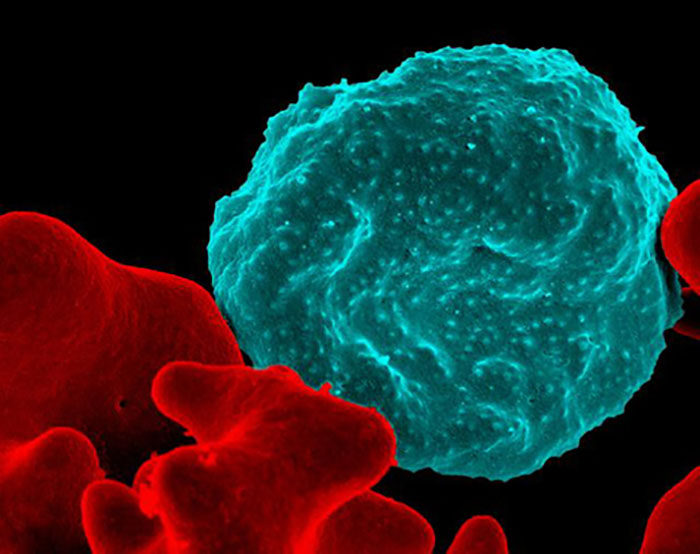Scientists find way to trap, kill malaria parasite
Washington University School of Medicine scientists have identified a “bottleneck” that may make it possible to trap and kill malaria parasites inside the cells they infect

Scientists may have found a way to imprison the malaria parasite inside red blood cells. In this electron micrograph, the malaria parasites appear in blue and uninfected red blood cells are shown in red. Image courtesy of the National Institute of Allergy and Infectious Diseases (NIAID).
The malaria parasite is among the world’s deadliest infectious agents. Malaria is spread mainly by the bite of infected mosquitoes and is most common in Africa. In 2012, an estimated 207 million cases of malaria occurred worldwide, leading to 627,000 deaths, according to the World Health Organization. Resistance to drug treatments is spreading among the parasite’s many strains, and researchers are working hard to find new drug targets.
The parasite invades red blood cells and as it does, it takes part of the host cell’s membrane with it. This allows the parasite to build a protective compartment around itself. To grow properly, steal nourishment and dump waste, the parasite then starts a series of major renovations that transform the red blood cell into a suitable home.
Disrupting protein passage
New research reveals the proteins that make these renovations must pass through a single pore in the parasite’s compartment to get into the red blood cell. When the scientists disrupted passage through that pore in cell cultures, the parasite stopped growing and died.
“The malaria parasite secretes hundreds of diverse proteins to seize control of red blood cells,” said microbiologist Josh R. Beck, PhD, a postdoctoral research scholar who led the study. “We’ve been searching for a single step that all those various proteins have to take to be secreted, and this looks like just such a bottleneck.”
A separate study by researchers at the Burnet Institute and Deakin University in Australia also highlights the importance of the pore to the parasite’s survival. Researchers believe blocking the pore leaves the parasite fatally imprisoned, unable to steal resources from the red blood cell or dispose of its wastes.
Beck and other researchers in the laboratory of Washington University microbiologist Daniel Goldberg, MD, PhD, study how malaria affects red blood cells.
In the new report, he and his colleagues looked at heat shock protein 101 (HSP101). Scientists named this family of proteins “heat shock” because they become active when cells are overheated or stressed. The proteins have multiple functions, including guiding the folding and unfolding of other proteins.
Promising target for malaria drug development
Previous studies have suggested that HSP101 might be involved in protein secretion. The researchers disabled HSP101 in cell cultures, expecting to block the discharge of some malarial proteins. To their surprise, they stopped all of them.
“We think this is a very promising target for drug development,” Goldberg said. “We’re a long way from getting a new drug, but in the short term we may look at screening a variety of compounds to see if they have the potential to block HSP101.”
The scientists think HSP101 may alter malarial proteins so that they can be secreted through a pore that opens into the red blood cell.
Beck noted that researchers at the Burnet Institute neutralized the parasite in a similar fashion by disabling another protein thought to be involved in the passage of proteins through this pore.
“That suggests there are multiple components of the process that we may be able to target with drugs,” he said. “In addition, many of the proteins involved in secretion are unlike any human proteins, which means we may be able to disable them without adversely affecting important human proteins.”
To read more about the study and access an audio report, visit the Newsroom.






